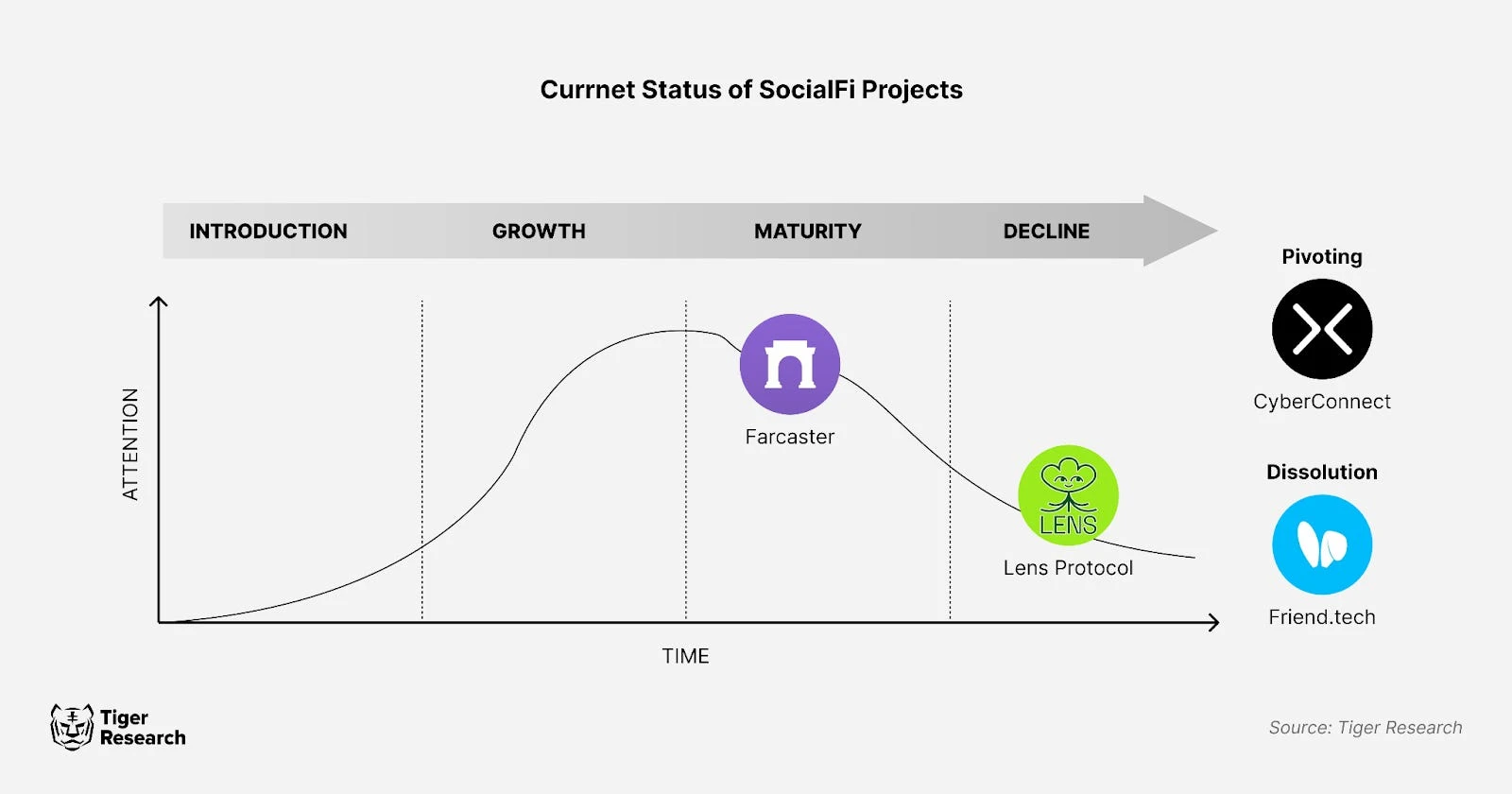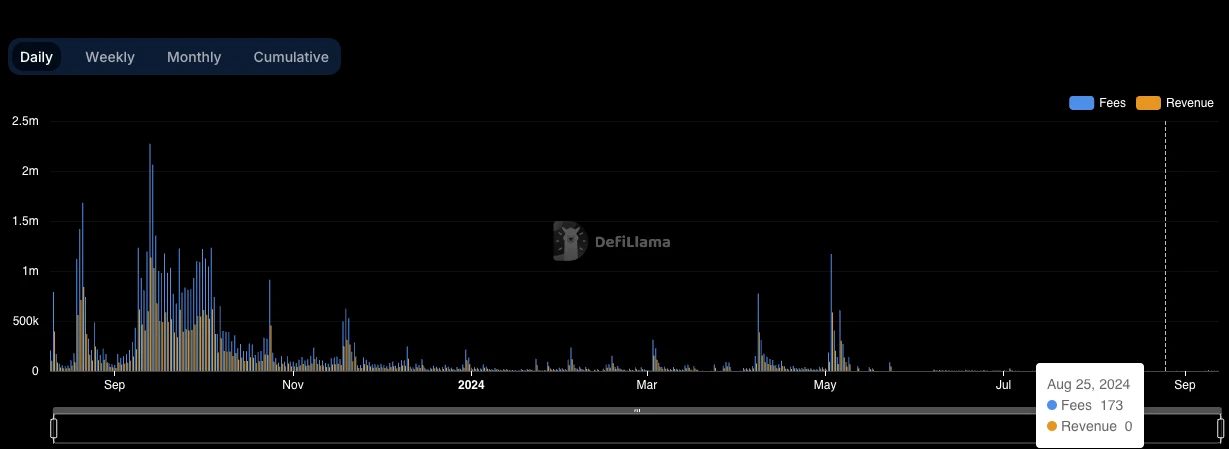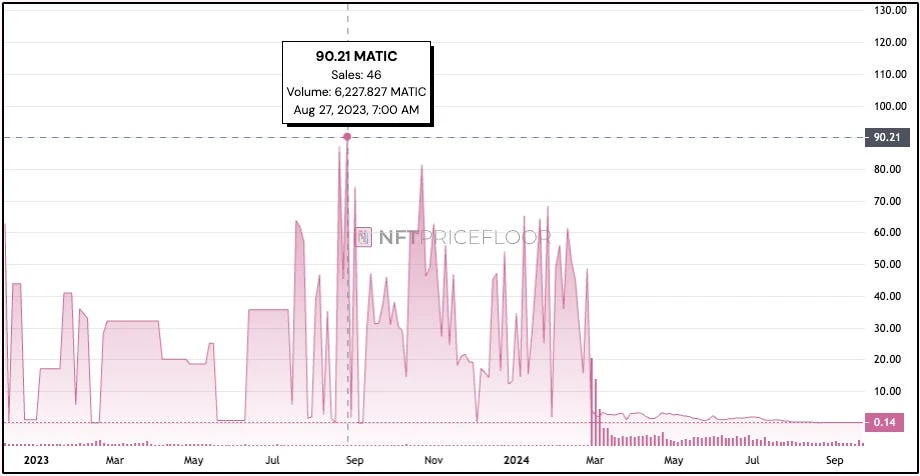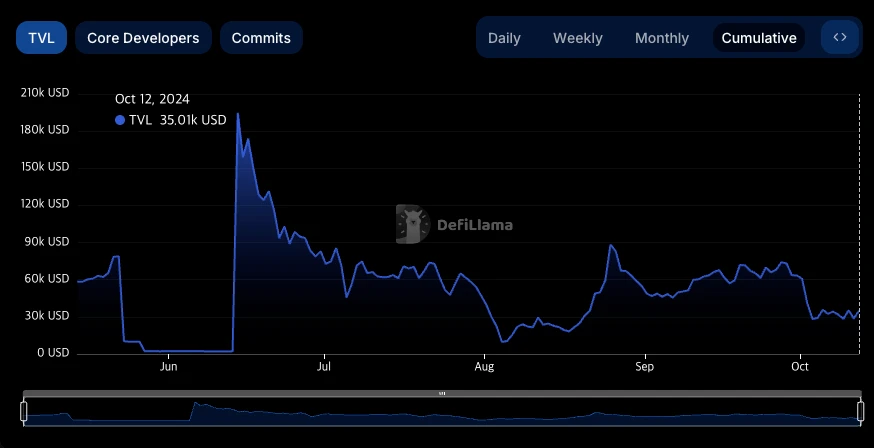Naik turunnya platform SocialFi arus utama dan pelajaran yang didapat
Artikel asli dari Laporan Penelitian Harimau
Disusun oleh Odaily Planet Daily Golem ( @web3_golem )
Ringkasan poin-poin utama:
-
SocialFi initially made a splash by combining decentralized finance with social media, allowing users to monetize content and control their data. However, the industry’s initial boom was short-lived. Platforms needed to work hard to maintain user engagement and provide innovative experiences beyond token speculation.
-
Platforms like Friend.tech highlight the plight of SocialFi, which relied heavily on early FOMO. Its users quickly dwindled due to its failure to provide consistent updates, fresh content, or a unique user experience, leading to a sharp drop in daily active users and engagement.
-
In order for SocialFi to recover and thrive, the business must go beyond replicating the traditional social media model on the blockchain. Achieving sustainable success requires integrating innovative user experiences, driving real user engagement and delivering real value beyond speculative investments, and partnerships that bridge Web2 and Web3 platforms.
From hype to reality
For a while, SocialFi was hailed as the next “big thing” in blockchain, merging decentralized finance and social media to create a platform where users can monetize their content, control their own data, and actively participate in governance.
This concept combines blockchain with social experiences, promising a paradigm shift similar to that brought about by pioneering platforms such as WeChat and TikTok. Just as platforms such as ZEPETO and Roblox have attracted younger generations with immersive digital world experiences, SocialFi aims to revolutionize the way people interact, transact and create value online.
Despite SocialFi’s huge potential, the initial excitement about it has faded due to declining user engagement, fading interest, and an unsustainable project model. As a result, user activity and engagement for once-mega projects that promised to revolutionize social interaction have also fallen sharply.
It’s important to understand why this decline occurred—not to find fault, but to summarize and identify opportunities for SocialFi’s recovery. This report delves into the rise and fall of major SocialFi platforms and their business lifecycles, analyzing the trends and challenges that companies must consider as they move forward.
Lessons learned from cutting-edge SocialFi projects
Sumber: Penelitian Harimau
Dissolution: Relinquishing control (Friend.tech)
Friend.tech experienced a complete decline | Source: @cryptokoryo Dune Dashboard
Friend.tech launched with great fanfare, quickly attracting users through airdrops and version updates (V2). Users were excited about the platforms unique model, which tokenized interactions on social media. This created an instant market for users to trade social influence and engagement. Early adopters flocked to the platform, generating a lot of user activity and token speculation.
Friend.techs official announcement on Twitter | Source: @friendtech Twitter
However, after the initial success, things suddenly changed for the Friend.tech team. After the release of V2, the team gave up control of the smart contract on September 8 and transferred control to an empty Ethereum address. This decision prevented any future updates or new features from being implemented.
While the platform is still up and running, the lack of new feature updates has caused the platform to lose its novelty and user engagement has rapidly declined. This product stagnation has a direct impact on user loyalty, as the lack of continuous updates has caused many early users to abandon the platform.
Friend.tech’s fees have dropped significantly | Source: Deflama
As the platform became stagnant, the FRIEND token also lost utility and became just another meme coin in the SocialFi ecosystem. By September 2024, Friend.techs revenue had dropped significantly, from over $2 million in fees generated on September 14, 2023 to $71 a year later. With no real use case, the value of the FRIEND token plummeted. This marked the de facto end of Friend.techs influence in the market.
Friend.tech’s fall shows the risks of premature decentralization when platform sustainability is not yet guaranteed. This is particularly dangerous in emerging markets such as SocialFi, where user interest can fade quickly. Companies should balance decentralization and central control to avoid project stagnation. User retention requires constant innovation and updates to keep them interested in the product, even if it has moved away from a decentralized mechanism.
Stagnation: The decline of the SocialFi platform (Lens Protocol)
Despite its initial promise, SocialFi faces significant challenges in maintaining long-term growth. Like other short-lived booms in the blockchain space, many SocialFi platforms have struggled after the early hype faded. Lens Protocol, which made waves during the 2024 boom, is a prime example.
Similar pattern to Farcaster | Source: @filarm Dune Dashboard
Lens Protocol has experienced a massive surge in sign-ups, fueled by market FOMO and early excitement about the decentralized social capabilities it describes. The platform’s growth seemed promising at first, with thousands of new users flocking to create accounts. However, once the novelty wore off, growth dropped drastically. In recent months, new sign-ups have plummeted to just 142, a stark contrast to the early activity.
The price of Lens Profile is also falling Source | NFT Price Floor
Another clear indicator of Lens Protocol’s decline is the sharp drop in Lens Profile prices. During the boom, the price of a Lens Profile could exceed $200, reflecting the high demand and high expectations for the platform. Today, the same asset is worth less than a dollar. This highlights the platform’s sharp decline in user interest and perceived value.
The sharp decline in asset value shows that if the SocialFi platform fails to provide continued value to users, they will quickly lose relevance to their users. For the SocialFi business to thrive, it must continue to attract users through meaningful content, community interaction, and real-world applications.
While Lens Protocol’s early performance excited the market, its sharp decline also sounded a warning bell for companies in the space. Without a clear long-term growth strategy, even the most promising platforms will fail.
Mature: But growing too fast for content to keep up (Farcaster)
Farcaster and its app, Warpcast, attracted a lot of attention in the early days, with the project raising over $150 million in funding in May 2024. Add to that the initial FOMO that led to a surge in daily active users, and the platform seemed poised for success.
From a daily peak of over 15,000 in early February to less than 500 new users currently | Source: @filarm Dune Dashboard
The platform’s inability to grow its user base despite infrastructure updates and the potential for decentralization points to a broader problem for SocialFi — sustaining interest after the initial hype. Farcaster saw a sharp drop in new user signups, from more than 15,000 in February to just 545 in September.
However, Farcasters daily user volume shows a positive trend|Source: The Block
Farcaster’s loyal user base is finally facing a shortage of content. While the number of daily users remains relatively stable, user engagement has dropped 60% from its peak. The main reason is a lack of engaging content. As a social platform, Farcaster should strive to provide enough compelling content to maintain users’ long-term interest.
Farcasters development also reveals a fact about blockchain-based platforms: content and service quality are far more important than decentralized functions. The prerequisite for any successful social application is continuous content production and user interaction. Blockchain-based social networks must invest heavily in content creation and incentivize meaningful user contributions. In terms of business insights, they should prioritize creating a diverse and engaging ecosystem that users are tempted to log in every day, rather than relying on airdrop speculation.
Transformation: New Business Model (Cyber)
Faced with declining user engagement and weakening connections, some SocialFi platforms have attempted to pivot to new business models in hopes of regaining momentum. One notable example is CyberConnect, which recently rebranded to Cyber and shifted its focus to L2 solutions.
Source: Deflama
While the shift seemed strategic, it did not rekindle user interest as Cyber had hoped. The platform’s TVL dropped drastically to just $35,000, well below its previous highs. Despite attempts to shift focus and rebrand, the challenges Cyber faced demonstrated that simply adapting to new technologies or trends is not enough to reignite long-term user engagement.
This reflects another important lesson for SocialFi: A shift to a new model or technology must be accompanied by an innovative, engaging user experience. Without continued innovation, even a strategic shift like the Cyber rebranding would be difficult to succeed.
What’s left for the future of SocialFi?
The rise and fall of platforms like Friend.tech exposed significant flaws in the SocialFi space. While initial interest and market FOMO can drive early adoption, long-term success requires more than speculative hype. Meaningful, engaging experiences are essential to sustaining user interest. Unfortunately, many projects have failed to deliver on their promises, leading to disillusionment and a sharp drop in user engagement.
The SocialFi project faces several core challenges that hinder its development. These challenges include lack of sustained user engagement, over-reliance on decentralization, and gaps in content and innovation. In addition , other issues in product services further exacerbate these challenges:
-
Inconvenient wallet use : Wallet use introduces too many extra steps, increases service complexity, and is often accompanied by unfriendly terminology. This makes the user experience less seamless and creates friction for new users who are not familiar with decentralized systems.
-
Lack of competitive differentiation : Many decentralized social media platforms are very similar to their Web2 counterparts, with little differentiation. Without a compelling advantage, they are often viewed as little more than “inconvenient alternatives,” limiting their ability to attract active users. Similar to how TikTok revolutionized social media through short-form content and virality, decentralized platforms must find strong competitive advantages to stand out.
-
Lack of native KOLs : The success of platforms like TikTok and Instagram can be largely attributed to the rise of native influencers. Influencers like the DAmelio sisters have built their own fan bases on TikTok, attracting new users and increasing engagement. The emergence of these KOLs is critical to driving the growth of new platforms. However, decentralized social media platforms have yet to cultivate native KOLs, which has hindered their potential for organic growth.
A key conclusion can be drawn from SocialFi’s predicament: it is not enough to replicate the Web2 model on blockchain technology. To succeed in this space, you need to provide users with truly novel experiences and tangible value. Only innovative and adaptable platforms will thrive in the long run.
This article is sourced from the internet: The rise and fall of mainstream SocialFi platforms and lessons learned
Related: Ethereum is sick, are these three medicines the right ones?
Original|Odaily Planet Daily ( @OdailyChina ) Author: Wenser ( @wenser 2010 ) On September 13, Danny Ryan, a researcher at the Ethereum Foundation, posted on GitHub that after careful consideration, he will indefinitely withdraw from the Ethereum L1 research and development work that has been invested for 7 years. As soon as the news came out, there was no shortage of uproar in the industry. After all, in the previously published article Where to Go? A Brief Analysis of the Three Major Abstract Problems Currently Facing the Ethereum Ecosystem , we also mentioned his Views on the L2 Network published in 2023. As the chief coordinator of the Ethereum The Merge upgrade, Danny Ryan is undoubtedly one of the insightful leaders of the Ethereum ecosystem. His resignation may also indirectly…

















